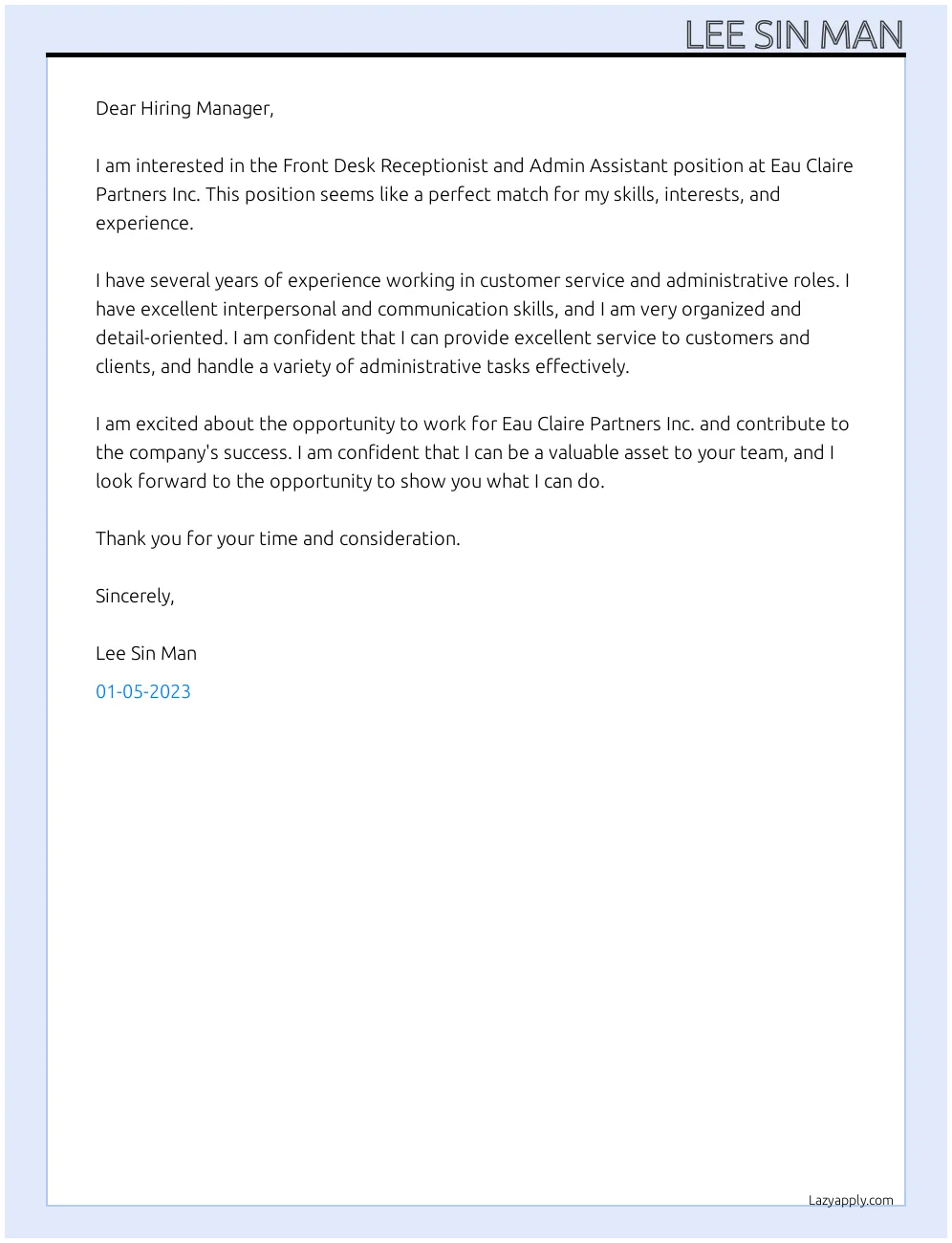Crafting the Perfect Receptionist Cover Letter
A well-crafted cover letter is your first opportunity to make a positive impression on a potential employer. For a receptionist position, it’s particularly crucial, as it showcases your communication skills, attention to detail, and professionalism – all essential qualities for this role. This guide will help you craft a compelling cover letter that highlights your skills, experience, and enthusiasm, increasing your chances of landing an interview and ultimately, the job. Remember that a cover letter should be tailored to each specific job application, demonstrating your genuine interest in the company and the position. Don’t settle for a generic template; personalize it to stand out from the competition. Consider the specific requirements listed in the job description and align your skills and experiences accordingly. The goal is to demonstrate you’re not just qualified, but the best fit.
Understanding the Role of a Receptionist
Before you start writing your cover letter, it’s important to understand the core responsibilities of a receptionist. This understanding will enable you to tailor your letter to showcase the skills and experiences that are most relevant to the role. The receptionist is often the first point of contact for visitors and callers, making a strong first impression crucial. This position demands excellent communication skills, both written and verbal, as well as strong organizational abilities and a professional demeanor. A receptionist must be able to handle multiple tasks simultaneously, manage schedules, and provide general administrative support. This understanding forms the basis of demonstrating your fit for the job, directly within your cover letter.
Key Responsibilities
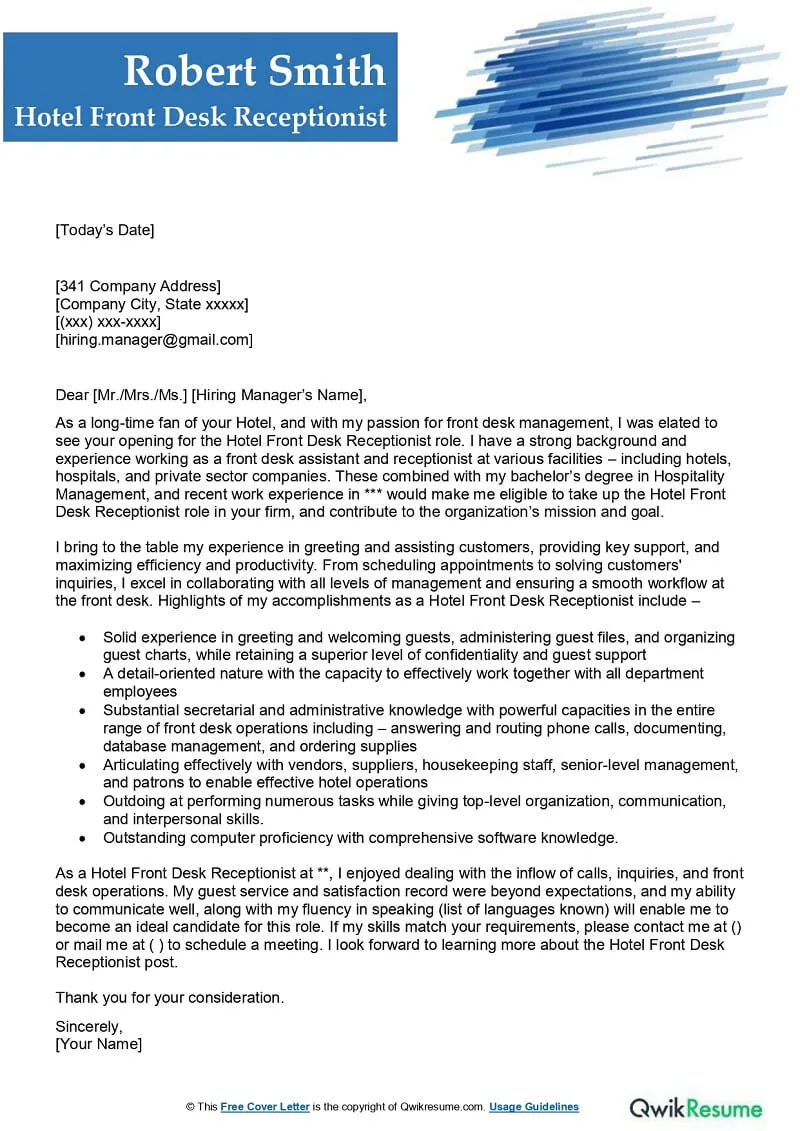
Receptionists are the face and voice of a company, so their responsibilities are diverse. They greet and assist visitors, answer and direct phone calls, manage mail and packages, and maintain office organization. They often schedule appointments, manage calendars, and provide general administrative support to various departments. Many receptionists are also responsible for handling basic bookkeeping tasks, managing office supplies, and ensuring the reception area is presentable. Effective receptionists are proficient in using office equipment, such as printers, scanners, and computers, and are adept at using communication software, such as email and instant messaging. They must also be skilled in maintaining confidentiality and handling sensitive information. All these responsibilities need to be considered when writing your cover letter.
Essential Skills for Receptionists
Receptionists need a blend of soft and hard skills to excel. Excellent communication and interpersonal skills are paramount, including active listening, clear speaking, and a friendly, approachable demeanor. Strong organizational abilities, including time management and multitasking, are also essential. Proficiency in office software, such as Microsoft Office Suite (Word, Excel, Outlook), is frequently required, and experience with phone systems and appointment scheduling software is a plus. Attention to detail, problem-solving skills, and the ability to remain calm under pressure are also valuable. Furthermore, a receptionist should be professional, reliable, and able to maintain confidentiality. Highlight these skills with specific examples in your cover letter to demonstrate how you’ve successfully applied them in the past, which will make your candidacy more impactful.
Tailoring Your Cover Letter to the Job
Generic cover letters rarely impress. Tailoring your letter to each specific job is crucial. This demonstrates genuine interest and shows you’ve taken the time to understand the company and the role. Review the job description carefully and identify the key skills and qualifications the employer is seeking. Then, align your experience and skills with these requirements, using specific examples from your past to illustrate your abilities. Don’t just list your skills; demonstrate how you’ve used them to achieve positive results. This will make your letter more compelling and increase your chances of getting an interview. A personalized cover letter is much more likely to get noticed than one that reads like a form letter.
Researching the Company
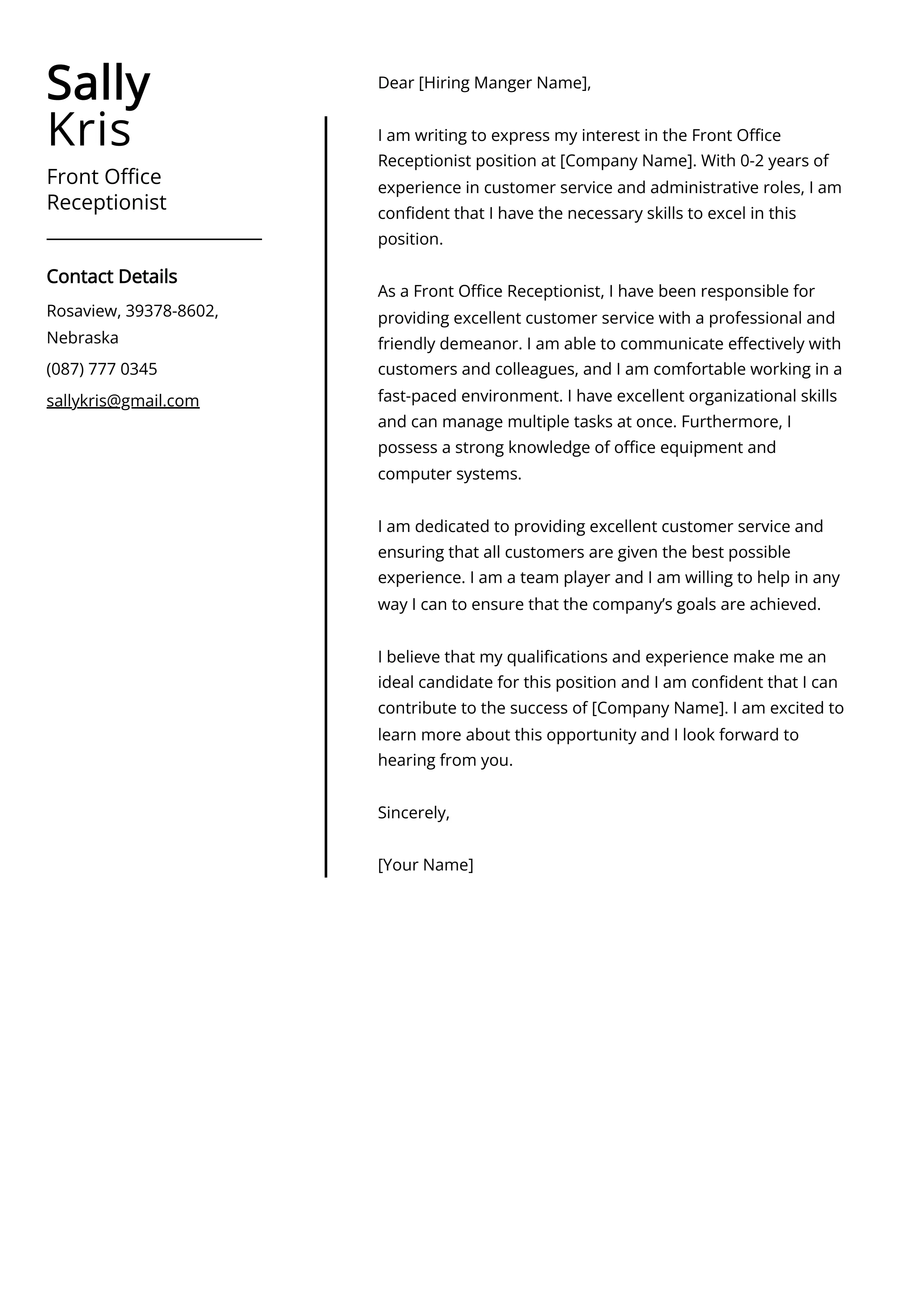
Before writing, research the company. Understand their mission, values, and recent news. Visit their website and social media profiles to get a feel for their culture. This research will allow you to personalize your letter and demonstrate your genuine interest. In your cover letter, mention something specific that you admire about the company or a project they’ve completed. This shows you’re invested and have taken the time to learn about the organization. Researching the company also helps you to understand their needs, which enables you to tailor your skills to address those needs directly in your application. This is a key step in making your cover letter stand out from the crowd.
Highlighting Relevant Experience
Focus on experiences directly relevant to the receptionist role. If you’ve worked in customer service, administrative roles, or any position that required communication, organization, and multitasking, highlight those experiences. Use the STAR method (Situation, Task, Action, Result) to describe your accomplishments. For example, instead of saying ‘Managed phone calls,’ you could say, ‘In my previous role, I managed an average of 50 phone calls per day, efficiently routing calls and providing excellent customer service, which resulted in a 15% increase in customer satisfaction.’ Quantify your achievements whenever possible to make them more impactful. Tailor your experience examples to align with the requirements listed in the job description, demonstrating your ability to perform the duties effectively.
Showcasing Your Skills
Clearly articulate your skills, both soft and hard. Mention your communication, interpersonal, and organizational abilities. Provide examples of how you’ve used these skills in previous roles. For example, you might say, ‘I have excellent communication skills and a proven ability to handle difficult situations with professionalism and grace. In my previous role, I consistently received positive feedback from customers for my ability to resolve their issues effectively.’ Also, mention your proficiency in relevant software (e.g., Microsoft Office, phone systems). If you have experience with appointment scheduling, managing mail, or other administrative tasks, make sure to highlight those skills as well. The key is to provide concrete examples and quantify your achievements to make your skills more persuasive.
Formatting and Structure
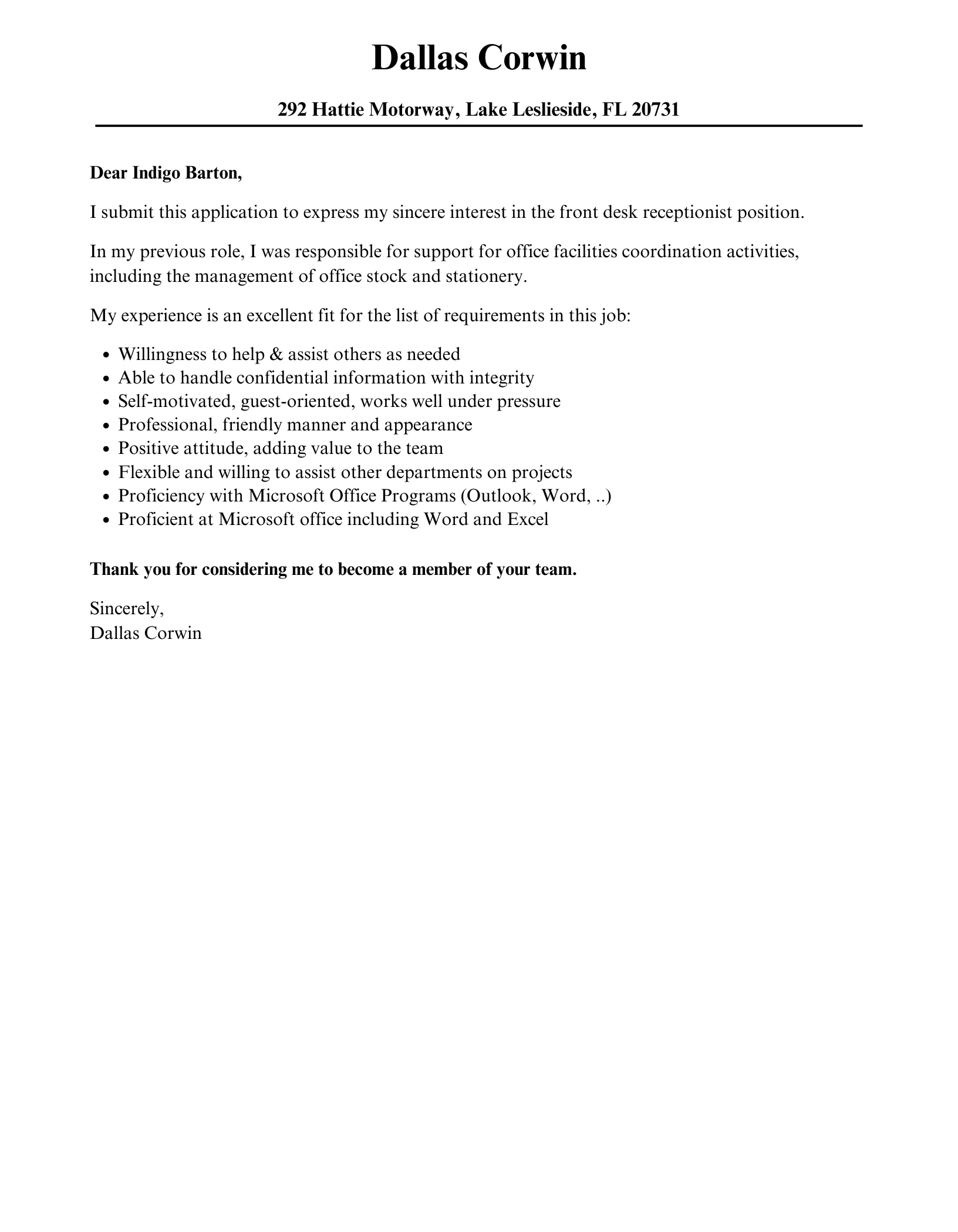
The format of your cover letter is as important as its content. Use a professional and easy-to-read format. Keep it concise, ideally no more than one page. Use a clear font, such as Arial or Times New Roman, with a font size between 10 and 12 points. Ensure your letter is well-organized, with clear paragraphs and headings. Use bullet points to highlight key skills or accomplishments. Proofread carefully for any typos or grammatical errors, as these can make a negative impression. The overall structure should be clear and easy for the hiring manager to navigate, allowing them to quickly grasp your qualifications and understand why you’re a great fit for the role.
Contact Information and Salutation
Begin with your contact information (name, address, phone number, and email address) at the top. Then, include the date and the employer’s contact information (if available). Address the hiring manager by name if possible. If you can’t find a name, use a professional salutation, such as ‘Dear Hiring Manager.’ Avoid generic salutations like ‘To Whom It May Concern.’ The salutation sets the tone for the rest of the letter, so it’s important to get it right. Addressing the hiring manager by name shows you’ve done your research and are attentive to detail.
Body Paragraphs Best Practices
The body of your cover letter is where you showcase your qualifications. Start with a strong opening paragraph that grabs the reader’s attention and states your interest in the position. The subsequent paragraphs should highlight your relevant experience and skills, providing specific examples of your accomplishments. Use the STAR method to describe your achievements. For instance, ‘In my previous role (Situation), I was tasked with improving customer satisfaction (Task). To achieve this, I implemented a new call routing system and provided additional training to my team (Action), resulting in a 20% increase in positive customer feedback (Result).’ Tailor your examples to the job description to demonstrate you’re the right fit.
Closing and Call to Action
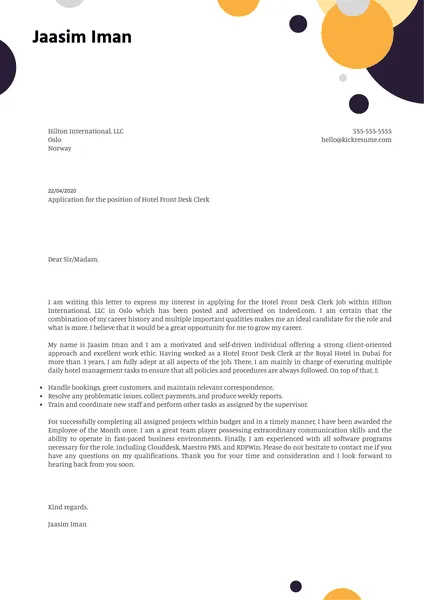
End your cover letter with a strong closing paragraph. Reiterate your interest in the position and express your enthusiasm for the opportunity. Thank the hiring manager for their time and consideration. Include a clear call to action, such as ‘I am eager to discuss my qualifications further in an interview.’ or ‘I look forward to hearing from you soon.’ Include your name and signature if submitting a physical letter. This is your chance to make a final, positive impression, leaving the employer excited to learn more about you.
Common Mistakes to Avoid
Several common mistakes can undermine your cover letter. Awareness of these pitfalls will help you craft a more effective and compelling application. Always ensure your cover letter is free of errors and tailored to the specific role you’re applying for. Avoid generic templates, and be sure to provide relevant experience and examples. A polished, well-written cover letter significantly increases your chances of landing an interview.
Generic Cover Letters
Generic cover letters are a major turnoff for hiring managers. They demonstrate a lack of interest and effort. Always customize your letter for each job application. Research the company and tailor your skills and experience to their specific needs. The purpose is to demonstrate genuine interest, not just a desire for any job. Show you’ve taken the time to understand the role and the company’s mission. Generic templates are easily recognizable and usually end up in the rejection pile. Personalized cover letters are far more effective in getting noticed.
Typos and Grammatical Errors

Typos and grammatical errors are a sign of carelessness and can damage your credibility. Proofread your cover letter multiple times, and consider having someone else review it for you. Use spell check and grammar check tools, but don’t rely on them entirely. Pay close attention to detail. Errors indicate a lack of attention to detail, an essential quality for a receptionist. A polished, error-free cover letter demonstrates your professionalism and commitment to quality, which will leave a positive impression on the hiring manager. A single mistake can undermine the entire application.
Negativity and Complaints
Avoid negativity and complaints in your cover letter. Focus on your accomplishments and the value you can bring to the company. Don’t mention issues you had with previous employers or jobs. Instead, highlight what you learned from those experiences and how you grew professionally. Maintain a positive and enthusiastic tone throughout your letter. Your cover letter is an advertisement for yourself; always present your skills and experience in the best possible light. The goal is to inspire confidence and enthusiasm, not to dwell on negative experiences.
Proofreading and Editing
Proofreading and editing are crucial steps in crafting a successful cover letter. Taking the time to review and refine your work ensures that it is free of errors and effectively communicates your qualifications. A well-edited cover letter demonstrates attention to detail and professionalism, both of which are essential for a receptionist. Before submitting your cover letter, take the time to thoroughly proofread it, checking for any grammatical errors, typos, or inconsistencies. Editing is about more than just correcting mistakes; it is also about ensuring that your message is clear, concise, and compelling.
Reviewing Your Cover Letter
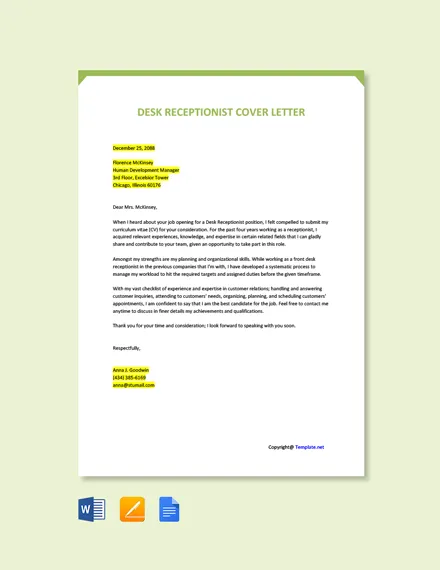
After writing your cover letter, review it carefully. Ensure that your contact information is correct and that the letter is addressed to the appropriate person. Check for any grammatical errors or typos. Make sure your experience and skills are relevant to the job description and that you have highlighted them effectively. Read the letter aloud to check for clarity and flow. Assess whether the tone is professional and enthusiastic. This step is critical to ensure your cover letter makes a strong positive impact. Reviewing allows you to catch any mistakes that you may have missed during the initial writing process.
Seeking Feedback
Ask a trusted friend, family member, or career advisor to review your cover letter and provide feedback. Another person can often catch errors or suggest improvements that you might miss. Ask them to evaluate the clarity, conciseness, and overall impact of your letter. Are your skills and experiences clearly highlighted? Does the letter convey your enthusiasm for the role? Is the tone appropriate and professional? Taking feedback is a vital part of the application process. Use the feedback you receive to refine your cover letter and make it even more effective. A second pair of eyes can make all the difference.
